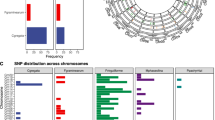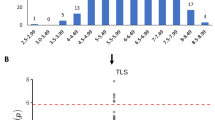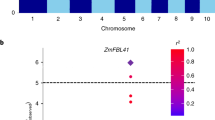Abstract
Specialized metabolites constitute key layers of immunity that underlie disease resistance in crops; however, challenges in resolving pathways limit our understanding of the functions and applications of these metabolites. In maize (Zea mays), the inducible accumulation of acidic terpenoids is increasingly considered to be a defence mechanism that contributes to disease resistance. Here, to understand maize antibiotic biosynthesis, we integrated association mapping, pan-genome multi-omic correlations, enzyme structure–function studies and targeted mutagenesis. We define ten genes in three zealexin (Zx) gene clusters that encode four sesquiterpene synthases and six cytochrome P450 proteins that collectively drive the production of diverse antibiotic cocktails. Quadruple mutants in which the ability to produce zealexins (ZXs) is blocked exhibit a broad-spectrum loss of disease resistance. Genetic redundancies ensuring pathway resiliency to single null mutations are combined with enzyme substrate promiscuity, creating a biosynthetic hourglass pathway that uses diverse substrates and in vivo combinatorial chemistry to yield complex antibiotic blends. The elucidated genetic basis of biochemical phenotypes that underlie disease resistance demonstrates a predominant maize defence pathway and informs innovative strategies for transferring chemical immunity between crops.
This is a preview of subscription content, access via your institution
Access options
Access Nature and 54 other Nature Portfolio journals
Get Nature+, our best-value online-access subscription
$29.99 / 30 days
cancel any time
Subscribe to this journal
Receive 12 digital issues and online access to articles
$119.00 per year
only $9.92 per issue
Buy this article
- Purchase on Springer Link
- Instant access to full article PDF
Prices may be subject to local taxes which are calculated during checkout






Similar content being viewed by others
Data availability
Publicly available datasets used in the study include the National Center for Biotechnology Information (NCBI) Sequence Read Archive project ID SRP115041 and the MaizeGDB BLAST database (https://maizegdb.org/popcorn/main/index.php). Raw read sequences have been deposited at the NCBI Gene Expression Omnibus under accession numbers GSE138961 and GSE138962. Raw sequence data from the root microbiome are available at NCBI BioProject under accession number PRJNA580260. Raw proteomic mass spectra have been deposited at the Mass Spectrometry Interactive Virtual Environment repository (ftp://massive.ucsd.edu/MSV000084285). Maize-related germplasm used in this research have been previously described27,39,43,44,45,72,73 and can be obtained from US Department of Agriculture Germplasm Resources Information Network (https://www.ars-grin.gov) and the Maize Genetics Cooperation Stock Center (http://maizecoop.cropsci.uiuc.edu). Where possible, gene identifiers used throughout the manuscript were in reference to B73 RefGen_v4 (https://www.maizegdb.org/genome/assembly/Zm-B73-REFERENCE-GRAMENE-4.0), which was used as a foundation for the study. All data are available from the corresponding author on request.
Code availability
For the gene-duplication date estimations, scripts to perform translations, alignments and backtranslations as well as data files and BEAST control files have been deposited at GitHub (https://github.com/TomJKono/Zealexin_Dating).
References
Ritchie, H. & Roser, M. Land use. Our World in Data https://ourworldindata.org/land-use (2020).
Evenson, R. E. & Gollin, D. Assessing the impact of the green revolution, 1960 to 2000. Science 300, 758–762 (2003).
Cartwright, D., Langcake, P., Pryce, R. J., Leworthy, D. P. & Ride, J. P. Chemical activation of host defence mechanisms as a basis for crop protection. Nature 267, 511–513 (1977).
Snyder, B. A. & Nicholson, R. L. Synthesis of phytoalexins in Sorghum as a site-specific response to fungal ingress. Science 248, 1637–1639 (1990).
Frey, M. et al. Analysis of a chemical plant defense mechanism in grasses. Science 277, 696–699 (1997).
Goswami, R. S. & Kistler, H. C. Heading for disaster: Fusarium graminearum on cereal crops. Mol. Plant Pathol. 5, 515–525 (2004).
Mueller, D. et al. Corn yield loss estimates due to diseases in the United States and Ontario, Canada from 2012 to 2015. Plant Health Prog. 17, 211–222 (2016).
Genetics for a warming world. Nat. Genet. 51, 1195–1195 (2019).
Dixon, R. A. Natural products and plant disease resistance. Nature 411, 843–847 (2001).
Jones, J. D. G. & Dangl, J. L. The plant immune system. Nature 444, 323–329 (2006).
van Loon, L. C., Rep, M. & Pieterse, C. M. J. Significance of inducible defense related proteins in infected plants. Annu. Rev. Phytopathol. 44, 135–162 (2006).
Moghe, G. D. & Kruse, L. H. The study of plant specialized metabolism: challenges and prospects in the genomics era. Am. J. Bot. 105, 959–962 (2018).
Wouters, F. C., Blanchette, B., Gershenzon, J. & Vassao, D. G. Plant defense and herbivore counter-defense: benzoxazinoids and insect herbivores. Phytochem. Rev. 15, 1127–1151 (2016).
Meihls, L. N. et al. Natural variation in maize aphid resistance is associated with 2,4-dihydroxy-7-methoxy-1,4-benzoxazin-3-one glucoside methyltransferase activity. Plant Cell 25, 2341–2355 (2013).
Fraenkel, G. S. The raison d’etre of secondary plant substances; these odd chemicals arose as a means of protecting plants from insects and now guide insects to food. Science 129, 1466–1470 (1959).
Schmelz, E. A. et al. Biosynthesis, elicitation and roles of monocot terpenoid phytoalexins. Plant J. 79, 659–678 (2014).
Vaughan, M. M. et al. Accumulation of terpenoid phytoalexins in maize roots is associated with drought tolerance. Plant Cell Environ. 38, 2195–2207 (2015).
Ding, Y. et al. Multiple genes recruited from hormone pathways partition maize diterpenoid defences. Nat. Plants 10, 1043–1056 (2019).
Casas, M. I. et al. Identification and characterization of maize salmon silks genes involved in insecticidal maysin biosynthesis. Plant Cell 28, 1297–1309 (2016).
Degenhardt, J. Indirect defense responses to herbivory in grasses. Plant Physiol. 149, 96–102 (2009).
Zila, C. T., Samayoa, L. F., Santiago, R., Butron, A. & Holland, J. B. A genome-wide association study reveals genes associated with Fusarium ear rot resistance in a maize core diversity panel. G3 3, 2095–2104 (2013).
Wiesner-Hanks, T. & Nelson, R. Multiple disease resistance in plants. Annu Rev. Phytopathol. 54, 229–252 (2016).
Stagnati, L. et al. A genome wide association study reveals markers and genes associated with resistance to Fusarium verticillioides infection of seedlings in a maize diversity panel. G3 9, 571–579 (2019).
Banerjee, A. & Hamberger, B. P450s controlling metabolic bifurcations in plant terpene specialized metabolism. Phytochem. Rev. 17, 81–111 (2018).
Karunanithi, P. S. & Zerbe, P. Terpene synthases as metabolic gatekeepers in the evolution of plant terpenoid chemical diversity. Front. Plant Sci. 10, 1166 (2019).
Block, A. K., Vaughan, M. M., Schmelz, E. A. & Christensen, S. A. Biosynthesis and function of terpenoid defense compounds in maize (Zea mays). Planta 249, 21–30 (2019).
Springer, N. M. et al. The maize W22 genome provides a foundation for functional genomics and transposon biology. Nat. Genet. 50, 1282–1288 (2018).
Ding, Y. Z. et al. Selinene volatiles are essential precursors for maize defense promoting fungal pathogen resistance. Plant Physiol. 175, 1455–1468 (2017).
Huffaker, A. et al. Novel acidic sesquiterpenoids constitute a dominant class of pathogen-induced phytoalexins in maize. Plant Physiol. 156, 2082–2097 (2011).
Mafu, S. et al. Discovery, biosynthesis and stress-related accumulation of dolabradiene-derived defenses in maize. Plant Physiol. 176, 2677–2690 (2018).
Mao, H., Liu, J., Ren, F., Peters, R. J. & Wang, Q. Characterization of CYP71Z18 indicates a role in maize zealexin biosynthesis. Phytochemistry 121, 4–10 (2016).
Basse, C. W. Dissecting defense-related and developmental transcriptional responses of maize during Ustilago maydis infection and subsequent tumor formation. Plant Physiol. 138, 1774–1784 (2005).
Kollner, T. G. et al. Protonation of a neutral (S)-β-bisabolene intermediate is involved in (S)-β-macrocarpene formation by the maize sesquiterpene synthases TPS6 and TPS11. J. Biol. Chem. 283, 20779–20788 (2008).
Christensen, S. A. et al. Fungal and herbivore elicitation of the novel maize sesquiterpenoid, zealexin A4, is attenuated by elevated CO2. Planta 247, 863–873 (2018).
van der Linde, K., Kastner, C., Kumlehn, J., Kahmann, R. & Doehlemann, G. Systemic virus-induced gene silencing allows functional characterization of maize genes during biotrophic interaction with Ustilago maydis. N. Phytol. 189, 471–483 (2011).
Shen, Q. et al. CYP71Z18 overexpression confers elevated blast resistance in transgenic rice. Plant Mol. Biol. 100, 579–589 (2019).
Medema, M. H. et al. Minimum information about a biosynthetic gene cluster. Nat. Chem. Biol. 11, 625–631 (2015).
Kersten, R. D., Diedrich, J. K., Yates, J. R. 3rd & Noel, J. P. Mechanism-based post-translational modification and inactivation in terpene synthases. ACS Chem. Biol. 10, 2501–2511 (2015).
Flint-Garcia, S. A. et al. Maize association population: a high-resolution platform for quantitative trait locus dissection. Plant J. 44, 1054–1064 (2005).
Kremling, K. A. G. et al. Dysregulation of expression correlates with rare-allele burden and fitness loss in maize. Nature 555, 520–523 (2018).
Jones, C. G. et al. Sandalwood fragrance biosynthesis involves sesquiterpene synthases of both the terpene synthase (TPS)-a and TPS-b subfamilies, including santalene synthases. J. Biol. Chem. 286, 17445–17454 (2011).
Swigonova, Z. et al. Close split of Sorghum and maize genome progenitors. Genome Res. 14, 1916–1923 (2004).
Lee, M. et al. Expanding the genetic map of maize with the intermated B73 x Mo17 (IBM) population. Plant Mol. Biol. 48, 453–461 (2002).
McMullen, M. D. et al. Genetic properties of the maize nested association mapping population. Science 325, 737–740 (2009).
Eichten, S. R. et al. B73-Mo17 near-isogenic lines demonstrate dispersed structural variation in maize. Plant Physiol. 156, 1679–1690 (2011).
Suzuki, R., Iijima, M., Okada, Y. & Okuyama, T. Chemical constituents of the style of Zea mays L. with glycation inhibitory activity. Chem. Pharm. Bull. 55, 153–155 (2007).
Ahmad, S. et al. Benzoxazinoid metabolites regulate innate immunity against aphids and fungi in maize. Plant Physiol. 157, 317–327 (2011).
Smissman, E. E., Lapidus, J. B. & Beck, S. D. Corn plant resistance factor. J. Org. Chem. 22, 220–220 (1957).
Pollastri, S. & Tattini, M. Flavonols: old compounds for old roles. Ann. Bot. 108, 1225–1233 (2011).
Lange, B. M. The evolution of plant secretory structures and emergence of terpenoid chemical diversity. Annu. Rev. Plant Biol. 66, 139–159 (2015).
Balmer, D., de Papajewski, D. V., Planchamp, C., Glauser, G. & Mauch-Mani, B. Induced resistance in maize is based on organ-specific defence responses. Plant J. 74, 213–225 (2013).
Yang, F. et al. A maize gene regulatory network for phenolic metabolism. Mol. Plant 10, 498–515 (2017).
Benson, J. M., Poland, J. A., Benson, B. M., Stromberg, E. L. & Nelson, R. J. Resistance to gray leaf spot of maize: genetic architecture and mechanisms elucidated through nested association mapping and near-isogenic line analysis. PLoS Genet. 11, e1005045 (2015).
Kump, K. L. et al. Genome-wide association study of quantitative resistance to southern leaf blight in the maize nested association mapping population. Nat. Genet. 43, 163–168 (2011).
Zuo, W. et al. A maize wall-associated kinase confers quantitative resistance to head smut. Nat. Genet. 47, 151–157 (2015).
Hamilton, R. H. A corn mutant deficient in 2,4-dihydroxy-7-methoxy-1,4-benzoxazin-3-one with an altered tolerance of atrazine. Weeds 12, 27–30 (1964).
Meunier, B., de Visser, S. P. & Shaik, S. Mechanism of oxidation reactions catalyzed by cytochrome P450 enzymes. Chem. Rev. 104, 3947–3980 (2004).
Henriques de Jesus, M. P. R. et al. Tat proteins as novel thylakoid membrane anchors organize a biosynthetic pathway in chloroplasts and increase product yield 5-fold. Metab. Eng. 44, 108–116 (2017).
Laursen, T. et al. Characterization of a dynamic metabolon producing the defense compound dhurrin in Sorghum. Science 354, 890–893 (2016).
Nelson, R., Wiesner-Hanks, T., Wisser, R. & Balint-Kurti, P. Navigating complexity to breed disease-resistant crops. Nat. Rev. Genet. 19, 21–33 (2018).
Chappell, J. & Hahlbrock, K. Transcription of plant defense genes in response to UV-light or fungal elicitor. Nature 311, 76–78 (1984).
Facchini, P. J. & Chappell, J. Gene family for an elicitor-induced sesquiterpene cyclase in tobacco. Proc. Natl Acad. Sci. USA 89, 11088–11092 (1992).
Koutsoudis, M. D., Tsaltas, D., Minogue, T. D. & von Bodman, S. B. Quorum-sensing regulation governs bacterial adhesion, biofilm development, and host colonization in Pantoea stewartii subspecies stewartii. Proc. Natl Acad. Sci. USA 103, 5983–5988 (2006).
Doblas-Ibanez, P. et al. Dominant, heritable resistance to Stewart’s wilt in maize is associated with an enhanced vascular defense response to infection with Pantoea stewartii. Mol. Plant Microbe Interact. 32, 1581–1597 (2019).
Bolger, A. M., Lohse, M. & Usadel, B. Trimmomatic: a flexible trimmer for Illumina sequence data. Bioinformatics 30, 2114–2120 (2014).
Kim, D., Landmead, B. & Salzberg, S. L. HISAT: a fast spliced aligner with low memory requirements. Nat. Methods 12, 357–360 (2015).
Tarasov, A., Vilella, A. J., Cuppen, E., Nijman, I. J. & Prins, P. Sambamba: fast processing of NGS alignment formats. Bioinformatics 31, 2032–2034 (2015).
Liao, Y., Smyth, G. K. & Shi, W. featureCounts: an efficient general purpose program for assigning sequence reads to genomic features. Bioinformatics 30, 923–930 (2014).
Anders, S. & Huber, W. Differential expression analysis for sequence count data. Genome Biol. 11, R106 (2010).
Kim, D. et al. TopHat2: accurate alignment of transcriptomes in the presence of insertions, deletions and gene fusions. Genome Biol. 14, R36 (2013).
Anders, S., Pyl, P. T. & Huber, W. HTSeq—a Python framework to work with high-throughput sequencing data. Bioinformatics 31, 166–169 (2015).
Schnable, P. S. et al. The B73 maize genome: complexity, diversity, and dynamics. Science 326, 1112–1115 (2009).
Sun, S. et al. Extensive intraspecific gene order and gene structural variations between Mo17 and other maize genomes. Nat. Genet. 50, 1289–1295 (2018).
Acknowledgements
We thank A. Steinbrenner, J. Chan, K. O’Leary, M. Broemmer, H. Riggleman, S. Reyes and S. Delgado for help with planting, treatments and sampling (UCSD); L. Smith (UCSD) for shared UCSD Biology Field Station management; B. Hamberger (Michigan State University) for the ElHMGR gene. This work was partially supported by the USDA-ARS National Programs for Food Safety and Plant Genetic Resources, Genomics and Genetic Improvement (to M.M.V., M.G.B. and S.A.C.). Mention of trade names or commercial products in this publication is solely for the purpose of providing specific information and does not imply recommendation or endorsement by the USDA. Research was supported by grants from the National Science Foundation, Division of Integrative Organismal Systems (NSF-IOS) (grant no. 1936492 to B.Y. and grant no. 1546899 to S.P.B.), USDA NIFA AFRI (grant no. 2018-67013-28125 to A.H. and E.S.) for sesquiterpenoids, NSF Plant-Biotic Interactions Program (grant no. 1758976 to E.S. and P.Z.) for diterpenoids, NSF Faculty Early Career Development Program (grant no. 1943591 to A.H.), the DOE Joint Genome Institute Community Science Program (JGI-CSP) (grant nos. CSP 2568 (to P.Z., J.B., E.S. and A.H.) and CSP 503420 (to A.H. and E.S.)) and fellowships provided by the NSF Graduate Research Fellowship Program (to K.M.M.), the U.C. Davis Innovation Institute for Food and Health (IIFH) Fellowship Program (to K.M.M. and P.Z.), the USDA NIFA Predoctoral Fellowship Program (award no. 2019-67011-29544, to K.M.M.) and a Fulbright Research Grant (E0581299, to M.B.).
Author information
Authors and Affiliations
Contributions
Y.D., P.R.W., E.P., P.Z., J.S., J.B., K.D., E.A.S. and A.H. designed the experiments and analysed the data. Y.D., E.P., S.A.C., T.G.K., P.Z., K.A.K. and E.S.B. designed, performed and analysed the transcriptome data. Y.D., E.S., A.S.K., K.M.M., P.Z., A.H. and E.A.S. performed MS experiments and MS-related metabolite data analysis. Y.D., E.S., K.M.M., P.Z., E.A.S. and A.H. performed and analysed the enzyme coexpression data. Z.S., A.-D.T. and S.P.B. analysed the combined proteome and transcriptome dataset. T.K. calculated estimates of gene evolution dates. D.R.N. assigned subfamily names for P450 proteins. M.M.V. and M.G.B. generated and analysed the root microbiome data. B.Y., S.N.C. and P.R.W. designed gRNA constructs and generated the zx1 zx2 zx3 and zx1 zx2 zx3 zx4 maize mutants. J.S. and M.B. performed metabolite purifications and analysed the NMR data. Y.D. and P.R.W. performed the in vitro and in vivo antibiotic resistance assays. Y.D., P.R.W., E.P., P.Z., E.A.S. and A.H. wrote the manuscript with input from all of the authors.
Corresponding author
Ethics declarations
Competing interests
The authors declare no competing interests.
Additional information
Peer review information: Nature Plants thanks Peter Balint-Kurti, Hugues Renault and the other, anonymous, reviewer(s) for their contribution to the peer review of this work.
Publisher’s note Springer Nature remains neutral with regard to jurisdictional claims in published maps and institutional affiliations.
Supplementary information
Supplementary Information
Supplementary Information.
Supplementary Tables
Supplementary Tables 1–15.
Rights and permissions
About this article
Cite this article
Ding, Y., Weckwerth, P.R., Poretsky, E. et al. Genetic elucidation of interconnected antibiotic pathways mediating maize innate immunity. Nat. Plants 6, 1375–1388 (2020). https://doi.org/10.1038/s41477-020-00787-9
Received:
Accepted:
Published:
Issue Date:
DOI: https://doi.org/10.1038/s41477-020-00787-9
This article is cited by
-
Characterization and fine mapping of a maize lesion mimic mutant (Les8) with enhanced resistance to Curvularia leaf spot and southern leaf blight
Theoretical and Applied Genetics (2024)
-
The terpene synthase gene family in maize – a clarification of existing community nomenclature
BMC Genomics (2023)
-
Sorghum and maize flavonoids are detrimental to growth and survival of fall armyworm Spodoptera frugiperda
Journal of Pest Science (2023)
-
Foxtail mosaic virus-induced gene silencing (VIGS) in switchgrass (Panicum virgatum L.)
Plant Methods (2022)
-
Phenolic sucrose esters: evolution, regulation, biosynthesis, and biological functions
Plant Molecular Biology (2022)



